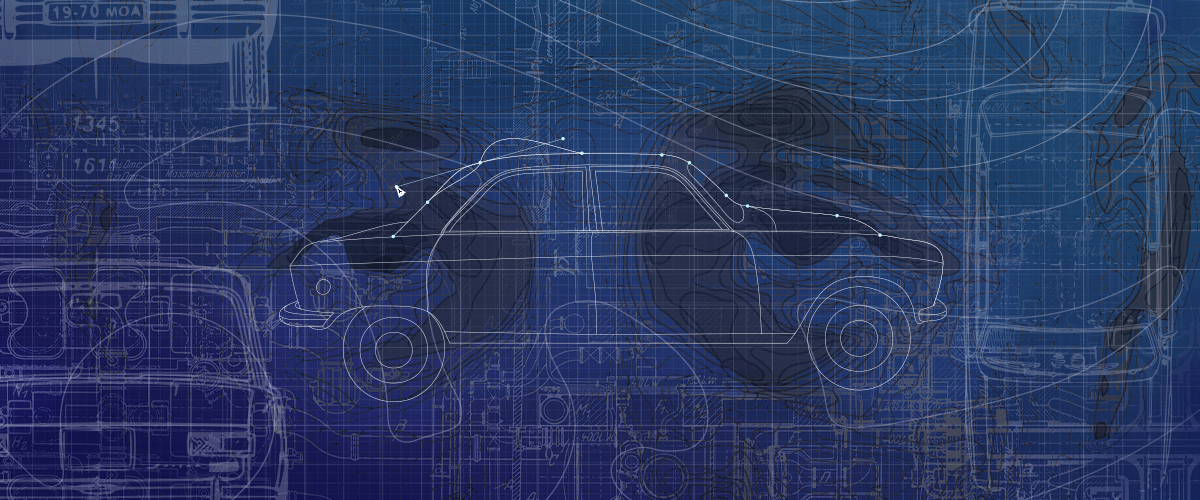A Bézier curve is a parametric curve -- a way for a computer to draw a curve and it is infinitely scalable. If you've ever used Adobe Illustrator, Inkscape, and of course BricsCAD, you'll have used bézier curves! They owe their name and popularisation to CAD pioneer and French man, Pierre Bézier. He developed Bézier curves in the 1960s and used them to create the iconic designs of Peugeot and Renault cars, long before other manufacturers were using CAD!
The bézier curve was developed by Pierre Bézier to machine bodywork and car parts with a computer...
In the 1960s he developed UNISURF CAD, one of the first CAD software packages. In 1968 the Peugeot model 204 bodywork was designed entirely using UNISURF. However, it was Paul de Castelijau who invented the bézier curve. for Citroën.
Bézier Curves, CAD, and Cars
The bézier curve was developed to allow engineers to create the complex curvature of a car's bodywork with a computer.
Unbelievably, the car industry was initially reluctant to adopt CAD for automotive design. At the end of the 1950s Bézier suggested that Renault should invest money in researching numerical controls. They declined and practically demoted him!
He resolved to research methods to apply numerical control for car body tooling and die-cast models anyway. He named this new system "UNISURF". Management were unimpressed. However, as luck would have it, in 1966 Renault and Peugeot signed an agreement to cooperate in research and development. A few of the engineers at Peugeot expressed an interest in UNISURF and aided with the development of the system.

The Peugeot 204 was the first car who's bodywork was completely build using UNISURF CAD. Image via Flickr dave_7
In 1968 they designed the whole body of the Peugeot model 204 in UNISURF. It was one of the first cars to be designed using CAD software. By 1999, 1,500 employees at Renault were using UNISURF CAD software.
A news report of the time showcases the new drawing and tooling capabilities of UNISURF (French). In it you can see the computer drawing ink on paper and machine tooling a part. The computer is using tape, is larger than my fridge and there is no mouse. It's incredible to think how groundbreaking the technology was at the time, given that we use CAD every day on our laptops.
Pierre Bézier
Pierre Bézier (1910-1999) started working on mathematical modeling from the start of his career. His doctorate study was in parametric polynomial curves, his dissertation entitled: "Essai de définition numérique des courbes et surfaces expérimentales" (Numerical definition test of experimental curves and surfaces).

by the 1970s even if all parts of the car were not designed in CAD, computer-aided design was certainly having an influence on automotive design, as can be seen in this Renault Alpine A310. During this time cars became squarer and more "computery" . Image credit: Alberto-g-rovi [CC BY 3.0], via Wikimedia Commons
During World War II Pierre Bézier spent 2 years in a prisoner camp for officers. However, he was undeterred. During his time at the camp he continued to develop his ideas and even formed study groups with other engineers.
In 1933 Bézier began working for Renault and remained there until his retirement in 1975. He started as a tool designer and finished as a managing staff member for technical development.

Another example of early, CAD influenced car design is the Peugeot 504. Image: Ermell [CC BY-SA 4.0], via Wikimedia Commons
In 1985 he received a Steven A. Coons award from ACM SIGGRAPH for his lifetime contribution to computer graphics and interactive techniques.
Paul de Castelijau
The origin of bézier curves comes from a 1912 mathematical discovery: the Bernstein Polynomial. However, it would be some 50 years before the bézier made its way to computer graphics.
Although it was Pierre Bézier who patented and popularized them, it was Paul de Castelijau who actually invented the bézier curve for Cirtoën in 1959. The algorithm used to calculate a bézier curve is known as 'de Casteljau's algorithm'.

By 1999 1500 staff members were using UNISURF at the company. Bézier curves made even cars as curvaceous as the Renault spider possible to design in CAD. Image via Flickr Alexandre Prevot
Bézier was responsible for the intuitive bézier control system: the nodes with attached control handles used to manipulate the curves, optimizing bézier curves for CAD. These handles define the shape of the curve on either side of the node allowing human-computer interaction.
Bézier curves in BricsCAD
BricsCAD uses Bézier curves to create splines, 2D fit polylines and even in its solids! Try them today. It's easy with BricsCAD. Try all of our products, for free for 30 days at www.bricsys.com. Freedom of choice, plus perpetual (permanent) product licenses that work with all languages, in all places. You'll love what we've built for you with BricsCAD.
Further reading:
- Obituary of Pierre Bézier
- Science Direct Biography of Pierre Bézier
- Social Science Research on CAD/CAM: Results of a First European Workshop
Disclaimer: All brand names and product names mentioned in this post are trademarks or service marks of their respective companies.
These links are being provided as a convenience and for informational purposes only; they do not constitute an endorsement or an approval by Bricsys of any of the products, services or opinions of the corporation or organization or individual. Bricsys bears no responsibility for the accuracy, legality or content of the external site or for that of subsequent links. Contact the external site for answers to questions regarding its content.
Explore BricsCAD
Download BricsCAD Free Trial | Sign Up For News & Updates | Shop Online For BricsCAD Desktop Software

